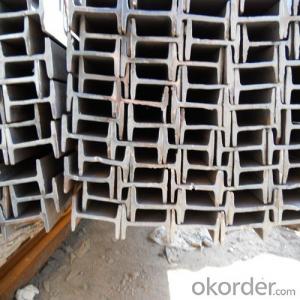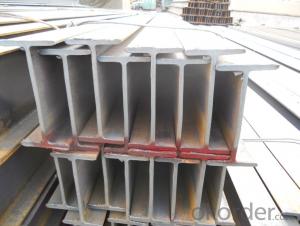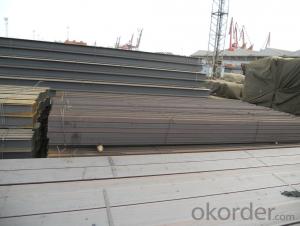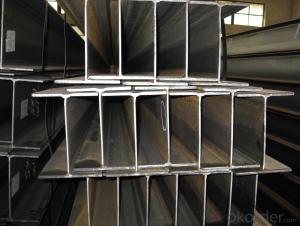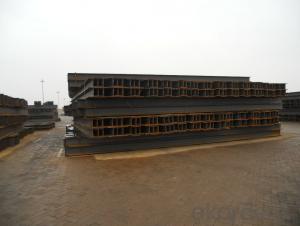HOT ROLLED STEEL H-BEAM HIGH QUALITY STRUCTURE STEEL GB JIS
- Loading Port:
- Tianjin
- Payment Terms:
- TT OR LC
- Min Order Qty:
- 100 m.t.
- Supply Capability:
- 40000 m.t./month
OKorder Service Pledge
OKorder Financial Service
You Might Also Like
Product Description:
Specifications of Hot Rolled Structural Steel H Beam
1. Standard: GB700-88, Q235B2.
2. Grade: Q235, SS400 or Equivalent
3. Length: 6m,10m, 12m as following table
4. Invoicing on theoretical weight or actual weight as customer request
5.Payment: TT or L/C
6. Sizes:
SIZE(mm) | DIMENSION(kg/m) |
100*100 | 16.9 |
125*125 | 23.6 |
150*75 | 14 |
150*150 | 31.1 |
148*100 | 20.7 |
198*99 | 17.8 |
200*100 | 20.9 |
248*124 | 25.1 |
250*125 | 29 |
Usage & Applications of Hot Rolled Structural Steel H Beam
Commercial building structure ;Pre-engineered buildings; Machinery support structure; Prefabricated structure; Medium scale bridges; Ship-building structure. etc.
Packaging & Delivery of Hot Rolled Structural Steel H Beam
1. Packing: it is nude packed in bundles by steel wire rod
2. Bundle weight: not more than 3.5MT for bulk vessel; less than 3 MT for container load
3. Marks:
Color marking: There will be color marking on both end of the bundle for the cargo delivered by bulk vessel. That makes it easily to distinguish at the destination port.
Tag mark: there will be tag mark tied up on the bundles. The information usually including supplier logo and name, product name, made in China, shipping marks and other information request by the customer.
If loading by container the marking is not needed, but we will prepare it as customer request.
4. Transportation: the goods are delivered by truck from mill to loading port, the maximum quantity can be loaded is around 40MTs by each truck. If the order quantity cannot reach the full truck loaded, the transportation cost per ton will be little higher than full load.
5. Delivered by container or bulk vessel
Production flow of Hot Rolled Structural Steel H Beam
Material prepare (billet) —heat up—rough rolling—precision rolling—cooling—packing—storage and transportation
- Q:What are the different factors that affect the cost of steel H-beams?
- There are several factors that can affect the cost of steel H-beams. The primary factors include the current market demand and supply of steel, the cost of raw materials such as iron ore and scrap metal, transportation and logistics costs, manufacturing and production costs, and any tariffs or taxes imposed on imported steel. Additionally, factors such as the size, weight, and specifications of the H-beam, as well as the reputation and brand of the manufacturer, can also influence the cost.
- Q:248 H steel GB thickness?
- GB H type steel: narrow flange HN250 * 125 models, 248 x 124 x 5 x 8 - 3289mm, cross-sectional area, weight 25.8kg/m.
- Q:How do steel H-beams contribute to energy efficiency?
- There are several ways in which steel H-beams contribute to energy efficiency. Firstly, they are commonly used in the construction industry to provide structural support for buildings and bridges. This helps to minimize excessive energy consumption during the construction process by efficiently distributing loads and reducing the need for additional materials. In addition, steel H-beams are known for their durability and longevity. Unlike materials like wood or concrete, steel beams do not deteriorate over time, resulting in less maintenance and repair work. This leads to reduced energy consumption and costs in the long term. Furthermore, steel is a highly recyclable material. H-beams can be easily melted down and repurposed, reducing the demand for new steel production. This recycling process requires less energy compared to the production of new steel, helping to conserve energy resources and decrease greenhouse gas emissions. Moreover, steel H-beams have excellent thermal properties. They efficiently transfer heat and cold due to their high thermal conductivity. This is particularly advantageous in energy-efficient building designs as it helps regulate temperature and reduces the need for excessive heating or cooling. By minimizing energy consumption for temperature control, steel H-beams contribute to overall energy efficiency in buildings. Overall, steel H-beams contribute to energy efficiency by reducing material waste during construction, providing long-lasting structural support, promoting recycling and reducing greenhouse gas emissions, and optimizing thermal properties for efficient temperature regulation. These qualities make steel H-beams a sustainable and energy-efficient solution for various construction applications.
- Q:Can steel H-beams be used in railway platforms?
- Certainly, railway platforms can utilize steel H-beams. Steel H-beams find widespread application in construction endeavours owing to their remarkable endurance, robustness, and adaptability. They offer outstanding structural reinforcement and possess the ability to bear substantial burdens, thereby making them fitting for railway platforms. Additionally, steel H-beams can be effortlessly crafted and set up, enabling expedient and economical construction. All in all, steel H-beams prove to be a trustworthy option for railway platforms, ensuring steadfastness and security for both passengers and trains.
- Q:What are the common applications of steel H-beams?
- Steel H-beams are widely used in various construction projects, especially in the structural and civil engineering fields. Some of the common applications of steel H-beams include: 1. Building Construction: Steel H-beams are frequently used as load-bearing members in the construction of buildings and other structures. They provide excellent strength and stability, making them ideal for supporting heavy loads and resisting various forces, such as wind and earthquakes. 2. Bridges: Steel H-beams are extensively used in the construction of bridges due to their ability to withstand high loads and support large spans. They are commonly used as main girders and piers, providing the necessary structural support to ensure the stability and durability of the bridge. 3. Industrial Structures: Steel H-beams are commonly used in the construction of industrial structures, such as warehouses, factories, and power plants. These structures often require large open spaces without the need for intermediate columns, and steel H-beams can provide the necessary strength and rigidity to fulfill these requirements. 4. Mezzanine Floors: Mezzanine floors are intermediate floors that are constructed within a building to create additional usable space. Steel H-beams are often used to support these floors, as they can efficiently bear the weight of the added load and allow for flexible space utilization. 5. Platforms and Walkways: Steel H-beams are frequently used to construct platforms and walkways in industrial settings, such as oil refineries, chemical plants, and power stations. These structures require high strength and stability to ensure the safety of workers and equipment, and steel H-beams are well-suited for this purpose. 6. Steel Frames: Steel H-beams are an essential component in the construction of steel frames for various structures. They form the skeleton of the building, providing the necessary support and stability to the overall structure. 7. Architectural Applications: Steel H-beams are also used in architectural applications to create unique and aesthetically pleasing structures. They can be used as decorative elements, such as exposed beams and columns, to enhance the visual appeal of buildings. In summary, steel H-beams find wide applications in the construction industry, including building construction, bridges, industrial structures, mezzanine floors, platforms and walkways, steel frames, and architectural designs. Their strength, stability, and versatility make them an essential component in various construction projects.
- Q:What are the standard lengths of steel H-beams?
- The standard lengths of steel H-beams can vary depending on the manufacturer and specific product specifications. However, in general, steel H-beams are often available in standard lengths ranging from 20 feet to 65 feet. These lengths are commonly used in construction and structural engineering applications, as they provide sufficient support and stability for various building projects. Additionally, some manufacturers may offer customized lengths based on specific customer requirements. It is always recommended to consult with the manufacturer or supplier to determine the exact standard lengths available for a particular steel H-beam product.
- Q:How do steel H-beams contribute to the overall cost-effectiveness of a project?
- Steel H-beams contribute to the overall cost-effectiveness of a project in several ways. Firstly, they are an incredibly strong and durable material, which means that they require minimal maintenance and have a long lifespan. This reduces the need for frequent repairs or replacements, resulting in cost savings over time. Additionally, steel H-beams are lightweight compared to other construction materials, such as concrete or timber, making them easier and cheaper to transport and handle on-site. This can lead to reduced labor costs and shorter construction times, ultimately saving money in the overall project budget. Moreover, steel H-beams can be prefabricated off-site, which allows for greater precision and efficiency in the construction process. This reduces the risk of errors and wastage, leading to cost savings in terms of materials and labor. Furthermore, steel is a sustainable and environmentally friendly material. It is 100% recyclable, meaning that at the end of its lifespan, it can be repurposed or recycled, reducing waste and minimizing the environmental impact of the project. This aligns with the growing demand for sustainable construction practices and can potentially result in cost savings through incentives or tax benefits. Overall, the utilization of steel H-beams in a construction project offers numerous cost-effective advantages. Their strength, durability, and low maintenance requirements ensure long-term cost savings, while their lightweight nature and prefabrication capabilities reduce transportation and labor costs. Additionally, the sustainability of steel contributes to potential financial benefits.
- Q:How are steel H-beams installed on construction sites?
- Steel H-beams are commonly used in construction sites for their strength and durability. The installation process of these beams involves several steps to ensure their proper placement and stability. Firstly, the construction site must be prepared for the installation of the steel H-beams. This includes clearing the area of any debris, leveling the ground, and ensuring that the foundation is strong enough to support the weight of the beams. Once the site is prepared, the beams are typically delivered to the construction site in sections. These sections are then lifted into position using cranes or other heavy machinery. The beams are carefully aligned and placed on temporary supports, known as cribbing, to hold them in place during the installation process. Next, the beams are bolted together at the connection points. This ensures that they form a solid and secure structure. Welding may also be used to reinforce the connections and increase their strength. After the beams are connected, they are adjusted into the desired position using hydraulic jacks or other lifting equipment. This ensures that the beams are level and properly aligned with the rest of the structure. Once the beams are in their final position, they are permanently secured to the foundation or supporting structure using bolts or welding. This ensures that they are stable and will not shift or move over time. Finally, the temporary supports, or cribbing, can be removed once the beams are securely in place. This allows for the completion of other construction tasks, such as the installation of flooring or walls. Overall, the installation of steel H-beams on construction sites requires careful planning, coordination, and the use of appropriate machinery. It is important to follow industry guidelines and standards to ensure the structural integrity and safety of the building.
- Q:How do steel H-beams perform in areas with high heat or thermal expansion?
- Steel H-beams are known for their strength and durability, but their performance in areas with high heat or thermal expansion can be affected. Heat causes materials to expand, and steel is no exception. When exposed to high temperatures, H-beams can experience thermal expansion, which can lead to potential issues such as distortion, bending, or even failure. The extent to which H-beams are affected by high heat or thermal expansion depends on several factors, including the temperature, duration of exposure, and the specific type of steel used. Generally, as the temperature increases, so does the expansion of the steel beams. However, different types of steel have varying coefficients of thermal expansion, meaning some may expand more than others under the same conditions. To mitigate the effects of thermal expansion, engineers and architects can take several measures. One common approach is to incorporate expansion joints into the design. These joints allow the steel beams to expand and contract freely without causing damage or distortion to the overall structure. Expansion joints can be strategically placed at intervals along the beams to accommodate the expected expansion and prevent the buildup of excessive stress. Another method is to use steel alloys that are specifically designed to withstand high temperatures and have lower coefficients of thermal expansion. These alloys, such as stainless steel or certain types of heat-resistant steels, are better suited for areas with high heat or thermal expansion. They can better handle the expansion and contraction without compromising the structural integrity. Furthermore, proper insulation and ventilation systems can help regulate the temperature within a building or structure, reducing the risk of extreme heat exposure to the H-beams. Adequate insulation can minimize heat transfer, while effective ventilation can dissipate excess heat and maintain a more stable environment. In conclusion, steel H-beams can be affected by high heat or thermal expansion, potentially leading to distortion or failure. However, through careful design considerations, such as incorporating expansion joints and using appropriate steel alloys, along with proper insulation and ventilation systems, the performance of steel H-beams in areas with high heat or thermal expansion can be improved and their structural integrity can be preserved.
- Q:Are there any standards or codes that govern the use of steel H-beams?
- Steel H-beams are governed by a variety of standards and codes. One well-known standard is the AISC specification, which provides guidelines for designing, fabricating, and erecting structural steel. This specification outlines requirements for H-beams, including dimensions, strength, and connection details. In the United States, the IBC is a widely accepted set of regulations that establishes minimum requirements for building design and construction. It references industry standards, including the AISC specification, to ensure the safe and efficient use of structural steel, including H-beams. Different countries have their own specific standards and codes for steel H-beams. For example, Europe commonly uses the Eurocode system, which offers a unified set of design codes for various construction materials, including steel. The Eurocodes address specific provisions for H-beams, such as material properties, design principles, and construction details. Engineers, architects, and construction professionals must be familiar with these standards and codes when using steel H-beams to ensure compliance with safety, performance, and quality requirements. Following these standards helps maintain the integrity and stability of structures, enhancing safety and longevity in the built environment.
1. Manufacturer Overview |
|
|---|---|
| Location | |
| Year Established | |
| Annual Output Value | |
| Main Markets | |
| Company Certifications | |
2. Manufacturer Certificates |
|
|---|---|
| a) Certification Name | |
| Range | |
| Reference | |
| Validity Period | |
3. Manufacturer Capability |
|
|---|---|
| a)Trade Capacity | |
| Nearest Port | |
| Export Percentage | |
| No.of Employees in Trade Department | |
| Language Spoken: | |
| b)Factory Information | |
| Factory Size: | |
| No. of Production Lines | |
| Contract Manufacturing | |
| Product Price Range | |
Send your message to us
HOT ROLLED STEEL H-BEAM HIGH QUALITY STRUCTURE STEEL GB JIS
- Loading Port:
- Tianjin
- Payment Terms:
- TT OR LC
- Min Order Qty:
- 100 m.t.
- Supply Capability:
- 40000 m.t./month
OKorder Service Pledge
OKorder Financial Service
Similar products
New products
Hot products
Related keywords
